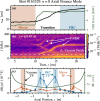Generation of field-reversed configurations via neutral beam injection
- PMID: 40221407
- PMCID: PMC11993635
- DOI: 10.1038/s41467-025-58849-5
Generation of field-reversed configurations via neutral beam injection
Abstract
We report evidence of successful generation of field-reversed configuration plasmas by neutral beam injection. This is achieved by trapping the steady-state beams in an initial seed plasma, hence providing a direct source of toroidally directed energetic ion current and increase plasma density and temperature until plasma and magnetic pressures become comparable. Magnetic flux trapping occurs gradually, and the change in topology from open field line to fully a formed field-reversed configuration is complete within ~ 10 ms. Field reversal is first established using a traditional metric and complemented by advanced reconstruction algorithms of the magnetic topology and plasma pressure profiles; observations of characteristic changes to fast-ion orbits inferred from magnetic fluctuations; and an experimentally validated model of field reversal by neutral beam injection. These results establish a field-reversed configuration formation method which may offer technological and economic advantages on a path to a future fusion energy system.
© 2025. The Author(s).
Conflict of interest statement
Competing interests: TAE Technologies is a private corporation owned and financially supported by its shareholders. The authors of this manuscript may have financial interest in the company.
Figures









References
-
- Tuszewski, M. Field reversed configurations. Nucl. Fusion28, 2033 (1988).
-
- Steinhauer, L. C. Review of field-reversed configurations. Phys. Plasmas18, 070501 (2011).
-
- Christofilos, N.C. Astron thermonuclear reactor. Technical report, California. Univ., Livermore. Radiation Lab., October 1958. Prepared for the Second U.N. International Conference on the Peaceful Uses of Atomic Energy, 1958.
-
- Davis, H. A., Meger, R. A. & Fleischmann, H. H. Generation of field-reversing e layers with millisecond lifetimes. Phys. Rev. Lett.37, 542–545 (1976).
-
- Blevin, H. & Thonemann, P. Experimental studies of a theta-pinch discharge. Nucl. Fusion,Suppl. 1, 55, (1962).
LinkOut - more resources
Full Text Sources

